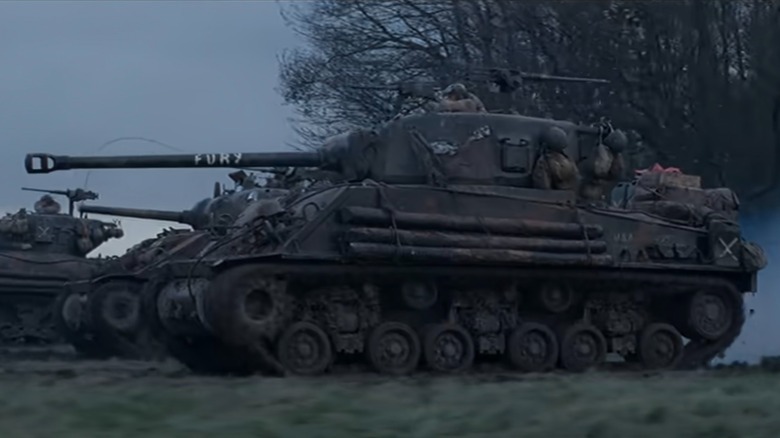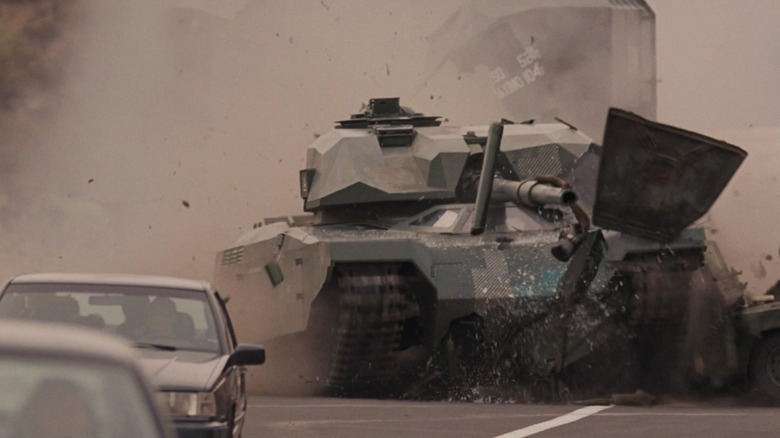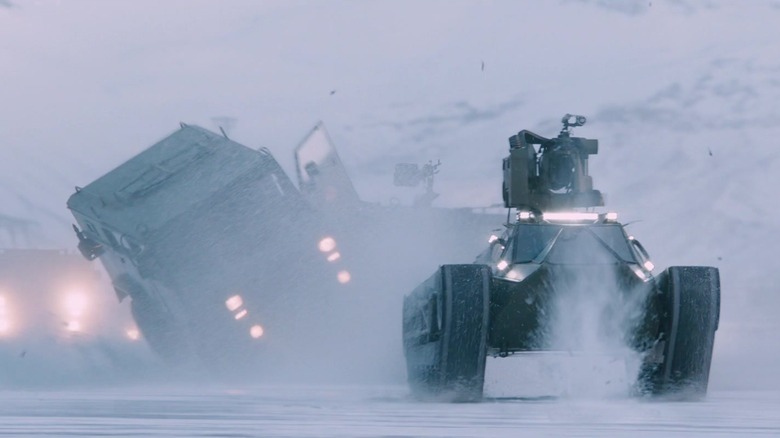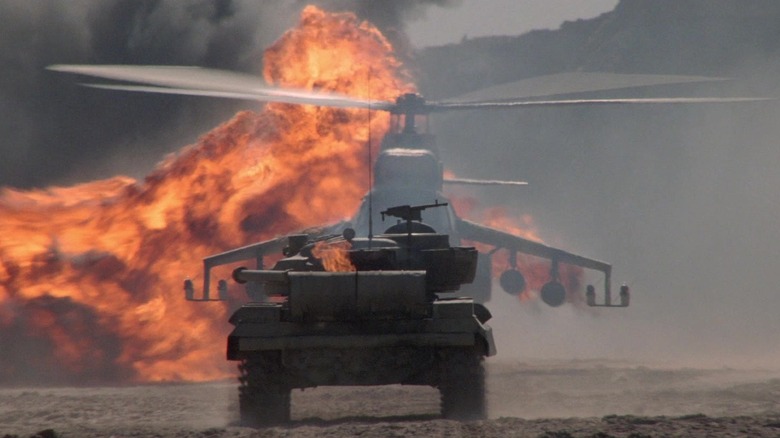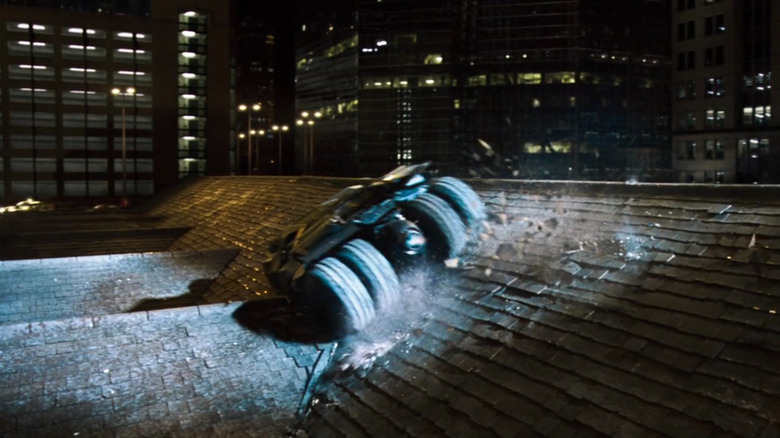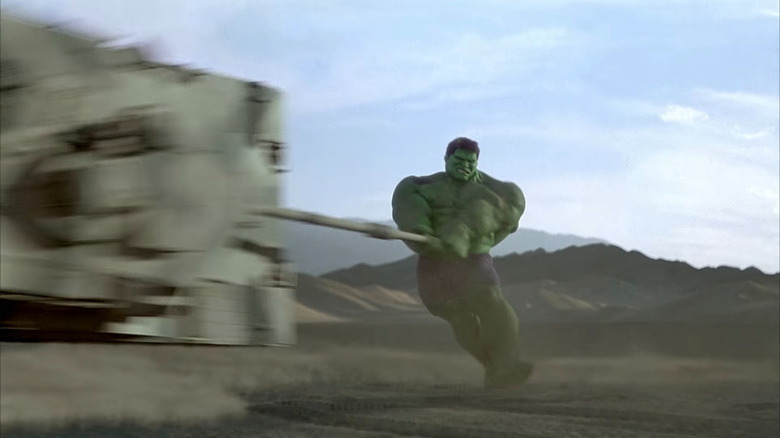5 Of Hollywood's Most Unrealistic Depictions Of Tanks
When you are making a feature film, there will always be some creative license needed to be taken when depicting certain professions, tasks, and worlds. These are mediums for storytelling, and story and character should always take precedence over the actual accuracy of a certain thing in the world. Filmmakers spend hours and hours researching whatever their film might be about — be it running a newspaper, maintaining a farm, or engaging in international espionage — but at the end of the day, the rules can be broken if something serves a greater dramatic, thematic, or aesthetic purpose.
Weaponry in films may have the greatest variance in how accurately they are depicted in the film than anything else, from their mechanics to the damage they cause, and perhaps more than anything, the film has shaped our cultural understanding of weaponry. While this is primarily about guns, it also extends out to something like military tanks, a staple of many war and action films. You may not think films can stretch the realism of something that large, which we all basically understand how it works, but Hollywood has taken some wild swings with tanks that could never happen in real life. That isn't to say these fanciful depictions of tanks are bad. They just give the audience a false sense of what these machines are actually like in the world.
Fast & Furious 6
"The Fast and the Furious" may have started as a street-level crime story, but as the franchise has progressed, they have essentially become science-fiction or superhero movies without any kind of tether to the real world in the slightest. Even with "2 Fast 2 Furious," directed by the late, great John Singleton, it was stylistically taking its car antics into cartoon land, and by the time we get to "Fast Five," all bets are off.
Our first of two tank sequences from the "Fast Saga" comes from "Fast & Furious 6," in which Luke Evans' Owen Shaw unleashes a tank on the franchise's main crew in a high-speed highway chase sequence. In the world of "Fast & Furious," this scene makes total sense, but it could never happen in real life. Just from the introduction of the tank, accuracy is out the window. The tank makes its way into the chase by bursting out of a truck that has been carrying it.
Tanks are massive, and when your vehicle weighs a ton (or dozens of tons in the case of tanks), acceleration is going to take some time. Even in your normal car, you aren't going to be able to go from zero to 60 mph in a millisecond, yet in "Fast & Furious 6," a gigantic tank can do that with no problem, not to mention keep up with a caravan of high-performance muscle cars. A very fun action sequence that could never happen.
The Fate of the Furious
Two films later, the "Fast Saga" returned to using a tank once again, and naturally, it appears once again in a high-speed chase, though this time it is being operated by our heroes. This particular tank is what's called a Ripsaw, which is a lightweight, high-speed tank. In terms of speed, what this tank is doing in the scene is pretty accurate, and the production did actually get a Ripsaw to use for the scene.
The problem comes with the terrain. This is a chase sequence that takes place on ice, and driving on ice is a lot different than driving on a road. For this Ripsaw to go as fast as it is and make all of the crazy maneuvers it does, you would not be using normal tank tracks for driving. Just like putting chains on your tires on a particularly snowy day, you have to do the same for tank tracks with grousers or some other technique. Otherwise, this tank would have no traction and be sliding all over the place, making for a chaotic chase sequence. Again, they did have a real ripsaw on the ice doing this stuff, but you need some movie magic to make it all cut together to make sense.
Rambo III
Tanks may seem like large, indestructible pieces of metal, but there are ways to combat a tank. The way you would not do that is what this pilot does in "Rambo III." In one of the film's battle scenes, a pilot in a battle helicopter decides to essentially play a game of chicken with Sylvester Stallone's John Rambo, leading to a head-on collision between the two vehicles. For the unrealistic side of the tank, Rambo is somehow simultaneously driving the tank and acting as the gunner, which isn't something that's all that feasible with most tanks.
Then there's the pilot. It should come as no surprise to anyone that the best way to take out a tank is not flying directly at it at full speed. For one, this is a helicopter equipped with missiles, and the pilot never fires a single one at the tank, which again is directly in front of him. All he does is spray non-targeted gunfire at the tank. Secondly, this vehicle is made to fly, allowing you to attack the tank from all sides. The front is not where you want to attack a tank. Had this helicopter flown to the other side and attacked from the rear, where the tank is less armored. The only reason to fly head-on into a tank and explode in a ball of fire is just a death wish by the pilot.
Batman Begins
So, the Batmobile isn't exactly a tank, but the Tumbler design from the "Batman" films directed by Christopher Nolan certainly takes their cue from tanks, certainly far more than any other Batmobile before or since. In a way, it's a similar concept to the Ripsaw used in "The Fate of the Furious" to maximize speed and lighten up the weight. For as lightweight of a tank as the Tumbler may be, there's no way it is as lightweight as one scene in "Batman Begins" depicts it as.
During the scene where Batman must race Rachel to the Batcave in order to give her the antidote to the Scarecrow's fear gas, he must drive the Batmobile along the roofs of Gotham at one point to evade the police. While roofs are solid and sturdy and do a good job of keeping out things like rain and squirrels, they are not the most structurally dense elements of a building. If you were to drop a vehicle that weighs somewhere around 10,000 pounds, if not more, on the top of a building, there is no way that roof would not collapse. Just think about how a tree that gets knocked over in a storm can crumble a roof, but instead, it's a tank. It's not only going to kick up some shingles but also be on its way. What would happen is that the people inside that building would be met with the worst surprise imaginable.
Hulk
As mentioned before, tanks are quite heavy machines. When a tank like the Soviet T-70 can be described as "light" and still weighs 10 tons, you know we are dealing with some pretty heavy material. So, the idea that someone could pick up a tank, swing it around like they are in a hammer-throwing competition, and throw it dozens of miles into the distance seems a little far-fetched. Well, that is why you need a superpowered being like the "Incredible Hulk" to perform such a task, which is what occurs in an action scene in Ang Lee's misunderstood, singular superhero flick "Hulk" from 2003.
Of course, this kind of thing could never happen in real life because superheroes don't exist. What makes the scene all the more puzzling is that there is a moment where Eric Bana's "Hulk" rips the top off of a tank, but it requires some time and effort to do so. Meanwhile, he's flinging a full tank miles away with seemingly little effort at all. The discrepancy between these two interactions with the weight of tanks doesn't really gel together. Of course, it's all make-believe, and we shouldn't worry about it. It's just fun to think about why this big, green monster had some trouble with one particular tank.
